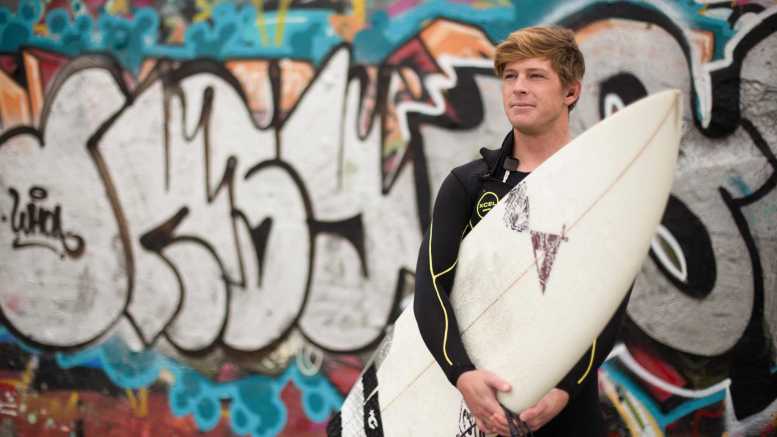Alumnus Colin Dwyer Tackles Mavericks Big Surf

Posted 9-1-17
This week, according to the World Surf League website, the WSL purchased the Mavericks surf contest to add it as a stop on the Big Wave World Tour. SF State alumnus and three-time invitee of the Mavericks event has his fingers crossed for one of the six available spots for local surfers.
Colin Dwyer, 26, from Pacifica, California, is a professional big wave surfer who has built his life around surfing Mavericks, which is one of the most dangerous waves on the planet. He has a bachelor’s degree in psychology from SF State and is entering the nursing program in the spring. He also works nights as an emergency room technician at John Muir Hospital.
 In between waves at Ocean Beach, Dwyer talks about his uncanny ability to juggle a career surfing 50-foot waves, emergency room situations, and studying full time at SF State.His comfort in the water can be attributed to his father, Steve, a high school teacher who was among the first group of surfers to paddle out at Mavericks.
In between waves at Ocean Beach, Dwyer talks about his uncanny ability to juggle a career surfing 50-foot waves, emergency room situations, and studying full time at SF State.His comfort in the water can be attributed to his father, Steve, a high school teacher who was among the first group of surfers to paddle out at Mavericks.“I can attribute my comfort in the ocean to my dad,” Dwyer said. “He would often say as he dragged me out into large surf when I was a kid that ‘you are going to hate me now, but you’ll thank me later.’”
It wasn’t long before he was joining his dad out at Mavericks. The first time Colin surfed Mavericks, he was 15 years old. Not only was he one of the youngest surfers to accomplish this feat, but he did so before the invention of the self-inflating wetsuit jacket, a safety device that releases carbon dioxide canisters to bring surfers to the surface.
Due to the violent nature in which Mavericks breaks, surfers can easily lose perception of what is up and what is down. Shane Dorian, a legendary big wave surfer, was surfing with Dwyer the day that he almost drown and subsequently invented the self-inflating vest.
The self-inflating vest has made Mavericks more accessible to a larger group of surfers as it provides a sense of security and cuts down on fatigue after a wipeout. However, some Mavericks purists believe that the vest has enabled incompetent surfers to put themselves, and rescue teams, in harm’s way.
“I have scars from the days before the vest that will never go away,” Dwyer said. “There’s been waves that have pushed me so deep underwater that I have blacked out trying to swim to the surface.”
What makes Mavericks considerably more perilous than the big waves found in the Hawaiian islands is that it breaks in deep, cold water a half mile from the rugged coast of Pillar Point in Half Moon Bay, California.
Holding one’s breath in the frigid abyss is considerably more difficult than in warm, opaque water. According to Cold Water Safety, an organization in place to warn swimmers about the dangers of cold water, “an average person’s ability to hold their breath in water below 60-degree Fahrenheit is one-third of what they can do in warmer water.”
Dwyer was surfing Mavericks in 2011 when Sion Miloski, a respected professional big wave surfer from the north shore of Oahu, Hawaii, drowned.
“I sat at the Old Princeton Landing, where all the surfers go after a session at Mavericks,” said Dwyer. “I ate a hamburger and drank a beer like I always do, but I couldn’t shake it out of my head that Sion, a husband, and father, whom I had just shared the lineup with, was dead.”
Dwyer attributes studying psychology to helping him internalize some of those horrific near-death experiences he’s had at Mavericks. How terrifying is Mavericks? World Champion Big Wave surfer, Grant Baker, said that surfing Mavericks is “one of the most feared challenges in sport” in an interview with National Geographic.
Learning the body’s response to stress helped Dwyer to identify the feeling building within himself and address it. “Now that I have matured a little, I’m able to use the fight-or flight response to focus myself on what I have to do.”
Dwyer describes surfing Mavericks as a cerebral sport – one that requires a surfer to think about their energy reserves like economic resources, much like a full-time-working student does. To cope with the inevitable stress and anxiety of Colin’s life, he enjoys breathing exercises, yoga and running.
To prepare for Mavericks, Dwyer practices apnea breath holds, a deep breathing technique used by free divers and spear fishermen to expand lung capacity. When he’s about to paddle out, he empties all of the carbon dioxides from his lungs and tries to inhale to the tips of his extremities, he said.
On the beach, he’ll go through a list of yoga poses to help with injury prevention. According to Dwyer, Mavericks doesn’t adhere to the laws of human anatomy when it delivers its punishment.
“I have had my ankle hit the back of my head; I’ve kissed my elbow, been contorted in all sorts of positions, which is why it’s so important to stay loose,” he said. “It’s like a car accident under water, Mavericks is a house of horror.”
Deep breathing helps to lower the blood pressure and lessen anxiety.
For Dwyer, it is the difference between an underwater blackout or making it to the surface.








